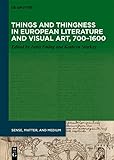Things and Thingness in European Literature and Visual Art, 700–1600 / ed. by Jutta Eming, Kathryn Starkey.
Material type: TextSeries: Sense, Matter, and Medium : New Approaches to Medieval Literary and Material Culture ; 7Publisher: Berlin ; Boston : De Gruyter, [2021]Copyright date: ©2022Description: 1 online resource (XII, 275 p.)Content type:
TextSeries: Sense, Matter, and Medium : New Approaches to Medieval Literary and Material Culture ; 7Publisher: Berlin ; Boston : De Gruyter, [2021]Copyright date: ©2022Description: 1 online resource (XII, 275 p.)Content type: - 9783110742329
- 9783110743081
- 9783110742985
- 809.93355 23/ger
- online - DeGruyter
- Issued also in print.
| Item type | Current library | Call number | URL | Status | Notes | Barcode | |
|---|---|---|---|---|---|---|---|
 eBook
eBook
|
Biblioteca "Angelicum" Pont. Univ. S.Tommaso d'Aquino Nuvola online | online - DeGruyter (Browse shelf(Opens below)) | Online access | Not for loan (Accesso limitato) | Accesso per gli utenti autorizzati / Access for authorized users | (dgr)9783110742985 |
Frontmatter -- Acknowledgments -- Contents -- Illustrations -- Introduction: The Materiality and Immateriality of Things -- 1 Intermedial Practice, Multisensory Perception: Lorenzo Monaco and the lavorii di mano around 1400 -- 2 Transporting the Holy City: Hans Tucher’s Letter from Jerusalem as Medium and Material Object -- 3 Producing Spiritual Concreteness: Prayed Coats for Mary in the German Late Middle Ages -- 4 How to Make a Knight: Reading Objects in the Ordene de chevalerie -- 5 Of Blades and Bodies: Material Objects in the Alliterative Morte Arthure -- 6 Barrow Agency: Reading Landscape in Felix’s Vita Guthlaci -- 7 The Things Narrative Is Made Of: A Latourian Reading of the Description of Enite’s Horse in Hartmann of Aue’s Erec -- 8 Community of Things: On the Constitution of the Ideal Kingdom of Crisa in Heinrich von Neustadt’s Apollonius von Tyrland -- 9 Printing Things: Materiality and Immateriality in Hieronymus Brunschwig’s Liber de arte distillandi de simplicibus -- 10 Seeing Like God: Envisioning History in Sixteenth-Century Iberia -- List of Abbreviations -- Bibliography -- Contributor Biographies -- Color Plates
restricted access online access with authorization star
http://purl.org/coar/access_right/c_16ec
The eleven chapters in this international volume draw on a variety of theoretical and methodological approaches to focus our attention on medieval and early modern things (ca. 700–1600). The range of things includes actual objects (the Altenburg Crucifixion, a copy of Hieronymus Brunschwig’s Liber de arte distillandi, a pilgrim’s letter), imagined objects (a prayed cloak for the Virgin Mary), and narrative objects in texts (the Alliterative Morte Arthure, the Ordene de Chevalerie, Hartmann von Aue’s Erec, Heinrich of Neustadt’s Apollonius of Tyre, Luís de Camões’s Os Lusíadas, and the vita of Saint Guthlac). Each in its own way, the papers consider how things do what they do in texts and art, often foregrounding the intersection between the material and the immaterial by exploring such questions as how things act, how they express power, and how texts and images represent them. Medieval and early modern things are repeatedly shown to be more than symbolic or passive, they are agentive and determinative in both their intra- and extradiegetic worlds. The things that are addressed in this volume are varied and are embedded, or entangled, in different contexts and societies, and yet they share a concerted engagement in human life.
Issued also in print.
Mode of access: Internet via World Wide Web.
In English.
Description based on online resource; title from PDF title page (publisher's Web site, viewed 25. Jun 2024)


